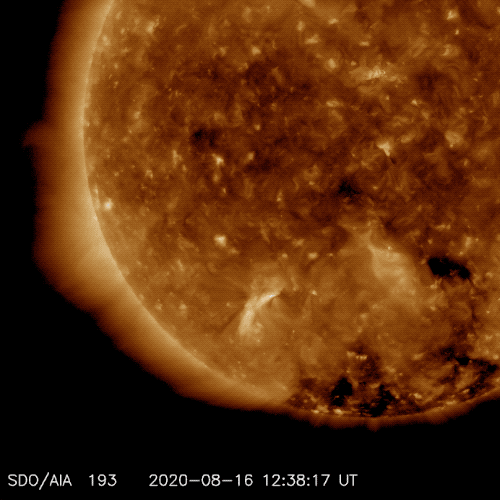Nasa Solar Flare August 2020
Co-author Jan Alvestad has a widely followed website Solar Terrestrial Activity Report and maintains high resolution sunspot counts based on images from the SDO NASA spacecraft. On May 29 2020 a family of sunspots dark spots that freckle the face of the Sun representing areas of complex magnetic fields sported the biggest solar flare since October 2017.

Image Of The Day Solar Flare Astronomy Solar Wind
This B1-class solar flare the second smallest class of flare peaked at 126pm.

Nasa solar flare august 2020. Consensus model results suggest an arriving glancing blow on August 20 -- producing unsettled to active geomagnetic field conditions with a chance for G1 - Minor storm levels. The flare also generated a solar energetic particle eruption that was detected by NASAs Solar Terrestrial Relations Observatory-Ahead or STEREO-A spacecraft at 751 UTC 351 am. The sun is heading toward solar minimum now.
NASAs Solar Dynamics Observatory observes the Aug. Footage of the extraordinary event was captured by NASAs Solar. 26th producing a C3-class solar flare.
1252020 100 pm In August the National Oceanic and Atmospheric Administration NOAA predicted that a powerful solar flare that had erupted from the Sun would hit Earths. A loop of solar material a coronal mass ejection CME can also be seen rising up off the right limb of the Sun. It helps us understand precursor environments that surround the active magnetic regions that can become the source of solar flares said Raphael Attie solar astronomer at NASAs Goddard Space Flight Center.
Sunspot AR2859 erupted on Aug. This B1-class solar flare the second smallest class of flare peaked at 126pm. The 25 hr blast sent a powerful shock wave rippling through the suns atmosphere shown here in a time-lapse movie from NASAs Solar Dynamics Observatory.
Late on August 16 2020 the Sun released a burst of light and energy known as a solar flare. And for Jupiter its on August 19th. 16th 1726 UT a B1-class solar flare took even longer to unfold.
16 2020 B-class flare at 131 171 and 193 angstroms. A NEW-CYCLE SOLAR FLARE. This B1-class solar flare the second smallest class of flare peaked at 126pm.
CMEs are huge bubbles of radiation and particles from the Sun. Solar flare on August 26 2021. At 0349 UT the magnetic canopy of new-cycle sunspot AR2770 erupted producing a C1-class solar flare.
By Mara Johnson-Groh NASAs Goddard Space Flight Center August 25 2020. NASAs Solar Dynamics Observatory captured this imagery of a solar flare as seen in the bright flash. Posted by NOAA NWS Space Weather Prediction Center on Monday August 17 2020.
August 17 2020. NASAs Solar Dynamics Observatory observes the Aug. August 31 2020 by Nicole Castro.
Late on August 16 2020 the Sun released a burst of light and energy known as a solar flare. A massive coronal mass ejection long-duration solar flare and CME left the sun August 16 2020 1726 UTC and will make a direct hit on the Earth. Active Region 2882 shown here near the middle of the Suns disk erupted with a moderate level solar flare on Oct.
August 17 2020. August 8th began with a bang. This B1-class solar flare the second smallest class of flare peaked at 126pm.
Solar flares are sometimes accompanied by a coronal mass ejection CME for short. This maybe the first CME scheduled to hit us this year but more CMEs could happen as activity on the Sun heats up via solar flares solar eruptions sunspots and CMEs. A preliminary conclusion was that Cycle 25 was going to start between August 2019 and January 2020.
Late on August 16 2020 the Sun released a burst of light and energy known as a solar flare. While intense activity such as sunspots and solar flares subside during solar minimum that doesnt mean the sun becomes dull. Sunspot counts were relatively high in 2014 and now they are sliding toward a low point expected in 2019-2020.
For the latest close-up views and discoveries from Jupiter follow NASAs Juno mission with NASAs Solar System Exploration website and social media. With more development the model could be used to one day inform forecasts of these intense bursts of solar radiation. NASAs Solar Dynamics Observatory observes the Aug.
August 2020 Coronal Holes and Fast Solar Wind The dark spot across the north pole of the Sun as captured in this image on July 31 2020 from NASAs Solar Dynamics Observatory or SDO is an area of relatively cooler material in the solar atmosphere known as a coronal hole. According to NASA solar storms are a variety of eruptions of mass and energy from the surface of the sun. The biggest solar flare of the year occurred last weekend by space April 6 2020 On April 4 NASAs Solar Dynamics Observatory recorded an ultraviolet flash from the AR2759 sunspot.
A weak solar flare measuring B12 at its peak erupted on August 16 2020 producing a coronal mass ejection CME. On this page you will find an overview of the strongest solar flares of the year 2020 together with links to more information in our archive and a video if available of the event. On Sunday August 16 a solar flare blasted through the Suns surface over a period of 25 hours.
16 2020 B-class flare at 131 171 and 193 angstroms. 16 2020 B-class flare at 131 171 and 193 angstroms. Late on August 16 2020 the Sun released a burst of light and energy known as a solar flare.
For Saturn opposition takes place this year on August 2nd. NASAs Solar Dynamics Observatory captured the explosions extreme ultraviolet flash. The eruption also caused a massive solar tsunami Watch the shadowy wave ripple across the sun in this false-color ultraviolet movie from NASAs Solar Dynamics Observatory.
Using data from NASAs Solar Dynamics Observatory or SDO scientists have developed a new model that successfully predicted seven of the Suns biggest flares from the last solar cycle out of a set of nine. Solar activity simply changes form. The flare however was not the main attraction.
New Sunspots Potentially Herald Increased Solar Activity. As youre enjoying Jupiter and Saturn during August watch as the increasingly full Moon slides. You know an explosion is powerful when it lasts for two hours.

News Ticker Sunspot Sunspots Solar Flare

The Sun Is Awakening With Solar Storms That Could Affect Earth The Washington Post

Coronal Holes And Fast Solar Wind Solar Cycle 25

Impressive Powerful Solar Flare Could Lead To Auroras This Weekend

August 2020 The Next Full Moon Is The Sturgeon Moon Nasa Solar System Exploration Next Full Moon Solar System Exploration Nasa Solar System

Print Of Solar Eclipse August 21 Wisconsin Solar And Lunar Eclipse Solar Eclipse Lunar Eclipse

A Slow Motion Solar Flare And Cme Spaceweather Com

Una Tormenta Solar Golpearia La Tierra El Jueves O Viernes Causaria Apagones Y Cortaria Las Comunicaciones Tormenta Ondas De Radio Erupciones Solares

La Nasa Ha Pubblicato Un Immagine Del Brillamento Solare Avvenuto Il 21 Gennaio Scorso Catturata Dal Satellite Goes 16 Che L Nebulose Astronomia Sistema Solare

Nasa Presenta Una Increible Foto De La Estacion Espacial Internacional Frente Al Sol International Space Station Space Station Sun Photo

Sun Earth Connection Sun And Earth Earth Our Solar System

Deepest Solar Eclipse On June 21 2020 Date Timing And Where To Watch What Is Solar Eclipse Solar Eclipse Astronomical Events

Esa Solar Orbiter S First Views Of The Sun Image Gallery Pictures Of The Sun Solar Telescope Solar Flare

Gms Small Flare Seen On The Sun August 16 2020

Solar Flare Astronomy Space Images Hubble Space

Gms Small Flare Seen On The Sun August 16 2020

Large Solar Flare On 9 25 11 Sdo Aia304 In 2020 Solar Flare Space Planets Hubble Space Telescope

